Surfing Etiquette & Tips
First thing, read our Ocean Safety page and also visit the Honolulu City & County ocean safety pages at http://www1.honolulu.gov/esd/oceansafety/.
– Aloha Surf Guide recommends that all beginning surfers hire a reputable and professional surf instructor. It will be more fun and safe – and many surf schools guarantee that you will catch some waves!
– If you respect locals and other surfers, and don’t drop in on others, you will probably have a good day. A smile and friendly attitude go a long way.
– Practice paddling, sitting on your board and basic control of your board before paddling out to the lineup. When paddling out, keep a good distance from the next surfer in front of you. If a large wave comes, the surfer in front of you might end up on top of you!
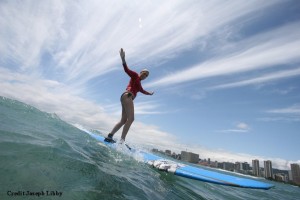 – Don’t surf just any break you wish to paddle out to. Ask your surf instructor which breaks are best for beginners. Canoes is the best place to start. Localism is a reality. Many surf spots have been surfed by families for generations, and are in some ways like your own back yard. Surf spots aren’t like basketball courts where you can just build a new one. Be careful where you go.
– Don’t surf just any break you wish to paddle out to. Ask your surf instructor which breaks are best for beginners. Canoes is the best place to start. Localism is a reality. Many surf spots have been surfed by families for generations, and are in some ways like your own back yard. Surf spots aren’t like basketball courts where you can just build a new one. Be careful where you go.
– Never take the first wave or set. After you paddle out, take a break and save up some energy. Check the conditions and orient yourself to the surf spot.

On the left, the surfer is ‘dropping in’ on the other surfer. The photo on the right shows a near collision and very unsafe situation.
– Always look around you and stay aware of others. When catching the wave, look over both shoulders to make sure nobody is already “claiming” that wave. If someone is barreling down the line wait for the next one. Don’t “drop in” on other surfers.
– When not surfing, keep yourself and your board pointed out to the ocean, away from the shoreline. Even after you wipe out, grab your board and look for oncoming surfers.
– It is best to try to always maintain control of your own surfboard. If you are losing control on a wave, try grabbing the rails firmly and lowering yourself down. Drag your legs and feet in the water to slow yourself down. “Save your body over your board.” This statement is often misunderstood. Only when all other options have been eliminated do you worry more about your body than your board. Always wear a leash.

This wave is being shared by two cooperative surfers.
– Sometimes other people’s boards and bodies will inadvertently come into contact with you and/or your board. Always make sure the other surfer is OK and apologize if you were wrong. If you made stupid mistake and dinged another board, you may want to offer to pay for the ding repair. If the other surfer was wrong, forget about it and paddle away.
– Never allow your board, or other boards, to come between you and the wave. The wave can literally throw the board at you. This is a very dangerous situation to be in for yourself and others around you.
– When someone is riding a wave, its your job to get out of their way, so they can enjoy the ride. Do not paddle across their line in an attempt to get to the shoulder of the wave as you will probably cut them off, creating a collision. It is often best to bite it and paddle into the breaking part of the wave.
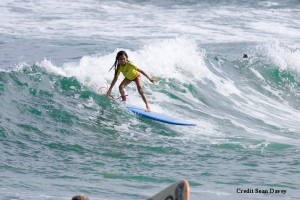 – Many surf spots have an inside break that is suitable for surfing. This is a good place to start since the more experienced surfers are usually outside seeking bigger and nicer waves. Be careful of shallow rock and coral.
– Many surf spots have an inside break that is suitable for surfing. This is a good place to start since the more experienced surfers are usually outside seeking bigger and nicer waves. Be careful of shallow rock and coral.
– Surf with a friend or make friends in the water. Don’t be afraid to ask others for pointers.
– Priority is a consideration but rarely respected, except when you bring in the tow aspect. The chain of priority is as follows: body surf, sponge, shortboard, longboard, SUP, tow.
– Relax out there and have fun!!
Tips
– Don’t bring anything expensive. If you really need your Ipod and smart phone, be ready to part with them. Surfer’s vehicles are sometimes subject to break-ins (depending on the spot).
– Start off with a long board. If you get the hang of it, consider stepping down in size. Your instructor and local surf shop can help determine the board best suited for you.
– Always wear a rash guard or shirt to prevent irritation. Many rash guard manufacturers offer products with UV protection. This will also save you some money in sunscreens.
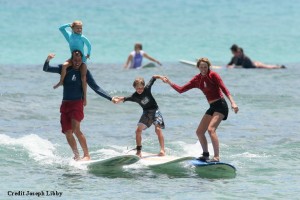 – Don’t surf the North Shore or West Side until you are ready and have trusty and experienced friends to go with. Some North Shore places are suitable for beginners, but we recommend you work with a reputable surf school.
– Don’t surf the North Shore or West Side until you are ready and have trusty and experienced friends to go with. Some North Shore places are suitable for beginners, but we recommend you work with a reputable surf school.
– Snorkel on flat days to study the ocean floor. This is the best way to know what is below you.
– Paddling primarily works the muscles in your back, neck, shoulders arms and stomach. If you are not physically ready, you might be too tired to catch a wave by the time you get to the lineup. Get good at paddling before you surf, or if you are travelling, work the proper muscle groups to get ready.
Duck Dive & Turtle Roll
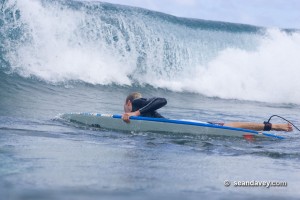
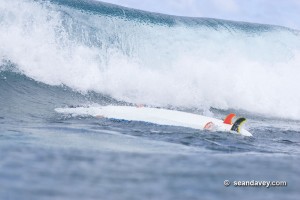 When a large wave breaks on you, it is a good idea to try to get “under” the wave to prevent being pounded and pushed closer to shore. The most common techniques are the Turtle Roll and the Duck Dive.Depending on wave size, your board, your body size and weight, and your own preference, as you practice, you will find which style fits you better. The turtle roll is generally used with larger boards in smaller wave conditions. This technique is executed by rolling the board over yourself with your hands firmly grasping the rails at the front 1/3 of the board, and giving a tug to pull the board down under the breaking wave.
When a large wave breaks on you, it is a good idea to try to get “under” the wave to prevent being pounded and pushed closer to shore. The most common techniques are the Turtle Roll and the Duck Dive.Depending on wave size, your board, your body size and weight, and your own preference, as you practice, you will find which style fits you better. The turtle roll is generally used with larger boards in smaller wave conditions. This technique is executed by rolling the board over yourself with your hands firmly grasping the rails at the front 1/3 of the board, and giving a tug to pull the board down under the breaking wave.
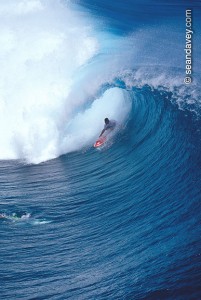
The surfer on the left has already executed the duck dive before the wave is breaking on him.

A well executed duck dive.
With smaller boards in large wave conditions, experienced surfers almost always use the duck dive. With this technique the surfer places his or her knee or foot on the middle of the board and uses momentum to push the board and your body under the breaking wave. The duck dive is better for big waves because the small and less bouyant board can be more easily pushed under the breaking wave.
Sharks
Shark sightings are rare and encounters are even less common. If you follow some ‘common sense’ guidelines, you are unlikely to ever see a shark in the water. Never surf alone, in the dark or at sun rise or sun set. Don’t wear Jewelry, this creates a flash or sparkle effect that wildlife might mistake for a fish gill. Don’t surf near a river mouth or near fisherman. Never surf with open wounds. Lastly, never surf after a rain storm or in murky waters. Watershed from rainwater carries a lot of dirt and debris into the ocean. This is unsafe because of the possibility of bacteria being in the water, but also unsafe because the murky waters can cause ocean life to lose their bearings and go places they might not usually go. Also, with the limited visibility, sharks tend to use their mouths to nibble on stuff to see what it is.